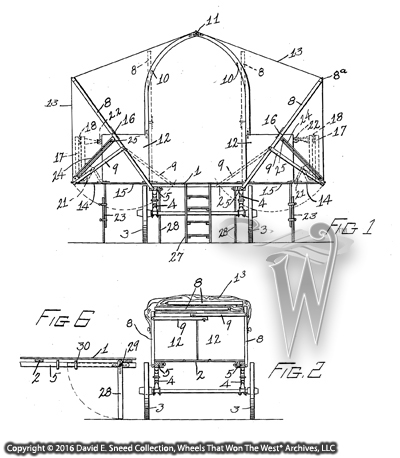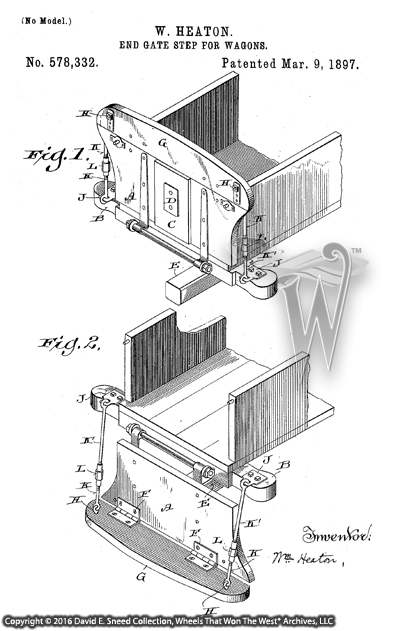It seems to me that it might be easier to discuss the existence of the Easter bunny compared to the challenges of convincing some that America's first transportation industry was full of innovation. After all, antique horse-drawn vehicles are just raw and rudimentary efforts that are only slightly elevated over stone age tools, right? Of course, that's wrong but some perceptions can be hard to overcome.
Decades ago, when I began researching this subject, I came across a number of period materials outlining the size and complexity of America's early transportation industry. It was the first of many breakthroughs helping highlight the need for sufficient historical reports. In the process, the discoveries opened doors to countless intriguing - and still untold - stories. I'll never forget the first time I accessed U.S. patent records related to horse-drawn wagons. With thousands upon thousands of patents filed and granted in the nineteenth century, it was dizzying to see so much ingenuity occurring in what is often called 'simpler' times.
Equally impressive, many of these ideas have served as foundational concepts for a wealth of advancements in the auto industry. After all, horse-drawn vehicles were the primary method of wheeled transportation in America for roughly 200 years and many of the most basic requirements remain similar today. During the mid-to-late 1800s and early1900s, numerous designs were created, adapted, and evolved for purposes of the day. Some of those ideas have even become part of our modern needs and activities.
So, with intellectual property being such a hot topic and well-known part of business these days, I thought we'd take a look at some wheeled ideas born at least a century ago that are still being used.
The Pop-Up Camper...
Surely, one of the great space-saving innovations of the mid-to-late 20th century is the pop-up camper. It's easy to tow, stow, maneuver, and use while packing a wealth of space for outdoor camping trips. It seems natural that something so advanced would have been developed by modern minds focused on a shrinking world and the need for efficient, cost-effective, multi-purpose designs, right? Well, not exactly.
Believe it or not, these concepts were first engineered for and incorporated into horse-drawn wagons. That's right... Wagons. Even in the late 1800s and early 1900s,camping was a popular activity in America. So, it's fairly easy to find a number of patents covering variations of pop-up and adjustable camp transportation.
 |
| This patent for a pop-up wagon camper was filed more than a century ago in 1916. |

Developed in the early 1890's, this patent for a wagon camper shows tremendous similarities to modern RV's.
While not a pop-up design, the McMaster Camping Car (wagon) was one of America's first true RV campers. It was patented in the1880s, included a host of home-style comforts, and was actually used on excursions within Yellowstone National Park. I wrote a blog on this ultra-rare vehicle some time ago.
The Refrigerated Truck...
From beverages and perishable foods to medical needs, refrigerated trucks and trailers are a very common sight today. Incredibly, it's an idea with roots to horse-drawn wagons and dates to as early as the 1870s.

This beverage cooler was designed for horse-drawn wagons. It dates to the early part of 1879 and incorporates block ice and ventilation fans for optimum refrigeration.
Mobile Scissor Lifts...
In today's worlds of manufacturing, construction, maintenance, and repair, the convenience of mobile scissor lifts continues to play a vital role. More secure than simple extension ladders and having an expanded work space, these rolling scaffolds are equipped for a multitude of uses. Even so, it's a concept that's been a part of American life for well over a century. In fact, the 1904 patent image below clearly shows the benefits of having an adjustable platform on wheels.

Submitted to the U.S. Patent office in 1904, this unique scissor-lift concept has become a valued part of life in the modern era.
Built-in Tailgate Steps...
Those 21st century 'step' additions to the rear bumpers and tailgates of pickup trucks must be an overdue idea, right? I mean, climbing into the back of a truck bed can be hard on the back and knees, especially if you're carrying a load. Well, back in the 1890s, the challenge was the same for our ancestors. As a result, having a collapsible step attached to a wagon's end gate (tailgate) was an equally important idea to some folks. Take a look at the patent image below.

Two Wisconsin men are credited with this nineteenth century patent featuring a built-in step to the back of a wagon box. Filed with the patent office in 1896, the idea has been emulated in modern pickup truck designs.
It seems that the old adage about 'the more things change, the more they stay the same,' still has a lot of merit. As such, the early innovations I shared above are just a few of the ideas initiated during the world of wagons that have found their way into modern life. Twin axle steering control, fixed axle steering, leaf spring suspension, bead locks for wheels/tires, run-flat tires, convertible tops, vehicle fenders, dump bed designs, automatic brakes, and so many other concepts that were drawn up in the horse-drawn era remain as pertinent ideas today.
No matter how deceivingly simple it may appear, America's first transportation industry and the specialized needs of wagons moving west created a world of innovation. It's a legacy so strong that we're still benefiting from ideas born in the horse-drawn age.
Please Note: As with each of our blog writings, all imagery and text is copyrighted with All Rights Reserved. The material may not be broadcast, published, rewritten, or redistributed without prior written permission from David E. Sneed, Wheels That Won The West® Archives, LLC